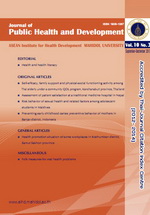Awareness of occupational post-exposure prophylaxis against HIV infection among health workers in Nyanza province, Kenya
Main Article Content
Abstract
This study attempts to determine the awareness of occupational post-exposure prophylaxis among
health workers in Nyanza province, Kenya. A cross-sectional study was conducted to collect data related to
knowledge, attitude, availability, and management support of post-exposure prophylaxis. Four hundred and
thirteen health workers in rural and urban health facilities responded to this self-administered questionnaire.
Eighteen percent of the respondents reported being exposed to at least one kind of occupational risk.
The highest percentage (57.9%) of health workers affected by occupational post-exposure prophylaxis was
among nurses. The majority (69.7%) of the exposures were caused by needle stick injuries, while 21% were
exposed to the splashing of body fluids on mucous membranes. Health workers in rural areas had a higher
awareness than those who worked in urban areas (74.5% versus 67.5%). The chi-square test revealed that the
variables associated with level of awareness were attitude and management support. After multiple logistic
regression was performed, it was found that a health worker who had a positive attitude and who worked
with the support of higher management was more likely to have a high level of awareness (Adj OR 2.82;
95% CI 1.50-5.30 and Adj OR 1.91; 95% CI 1.03-3.52 respectively).
It is recommended that health workers should be encouraged to have a more positive attitude towards
their behavior. In addition, a support system should be set up and health workers should use a facility-based
review of universal precaution procedures in order to decrease occupational exposure.
health workers in Nyanza province, Kenya. A cross-sectional study was conducted to collect data related to
knowledge, attitude, availability, and management support of post-exposure prophylaxis. Four hundred and
thirteen health workers in rural and urban health facilities responded to this self-administered questionnaire.
Eighteen percent of the respondents reported being exposed to at least one kind of occupational risk.
The highest percentage (57.9%) of health workers affected by occupational post-exposure prophylaxis was
among nurses. The majority (69.7%) of the exposures were caused by needle stick injuries, while 21% were
exposed to the splashing of body fluids on mucous membranes. Health workers in rural areas had a higher
awareness than those who worked in urban areas (74.5% versus 67.5%). The chi-square test revealed that the
variables associated with level of awareness were attitude and management support. After multiple logistic
regression was performed, it was found that a health worker who had a positive attitude and who worked
with the support of higher management was more likely to have a high level of awareness (Adj OR 2.82;
95% CI 1.50-5.30 and Adj OR 1.91; 95% CI 1.03-3.52 respectively).
It is recommended that health workers should be encouraged to have a more positive attitude towards
their behavior. In addition, a support system should be set up and health workers should use a facility-based
review of universal precaution procedures in order to decrease occupational exposure.
Article Details
How to Cite
1.
Owino SO, Srivanichakorn S, Thepthien B- on. Awareness of occupational post-exposure prophylaxis against HIV infection among health workers in Nyanza province, Kenya. J Public Hlth Dev [internet]. 2013 Aug. 14 [cited 2025 Dec. 27];11(2):19-30. available from: https://he01.tci-thaijo.org/index.php/AIHD-MU/article/view/10946
Section
Original Articles


